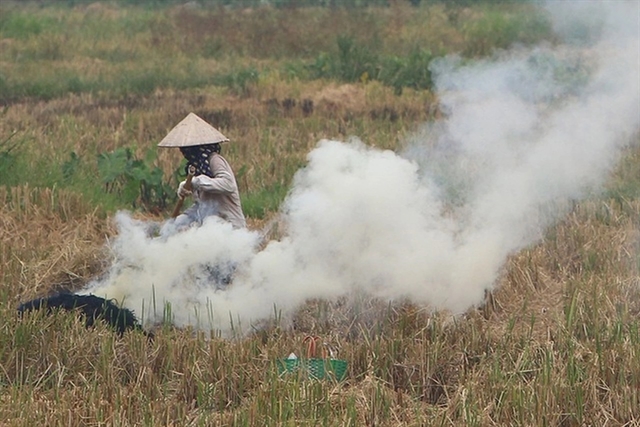 |
| Burning straw in the suburbs of Hà Nội is considered one of the causes of air pollution. Photo dantri.com.vn |
HÀ NỘI – Rural areas in the northern region are experiencing periods of severely deteriorated air quality, with fine particulate matter (PM2.5) levels rising significantly—some areas exceed the standard limit by up to 3.5 times, according to official monitoring.
The Ministry of Natural Resources and Environment has recently published the 2023 National Environmental Status Report, themed 'Rural Environment – Current State and Solutions'.
The report reflects the state of environmental quality in rural areas, identifies risks causing environmental pollution, highlights pressing environmental issues in rural regions over recent years, and pinpoints the main pressures and causes of rural environmental pollution.
As of 2023, statistics show that more than 62 million people live in rural areas, accounting for nearly 62 per cent of the national population.
Monitoring results reveal that air quality in rural northern Việt Nam sometimes deteriorate to critical levels, with PM2.5 concentrations exceeding standard limits by up to 3.5 times.
Air pollution varies by region, with the north typically experiencing higher levels than Tây Nguyên (the Central Highlands) and the south.
In rural areas, craft villages are among the most polluted.
For example, results from villages like Lại Xuân in Thủy Nguyên District of Hải Phòng City, Phong Khê and Văn Môn in Bắc Ninh Province, and Ninh Văn in Ninh Bình Province indicate that suspended dust levels in some areas are nearly twice the standard limit.
In Văn Môn Village, near the Mẫn Xá aluminium-casting craft village, average annual PM2.5 levels have exceeded standard limits continuously since 2020.
Similarly, areas near industrial zones, such as Phong Khê 2 and Lỗ Sung industrial clusters in Bắc Ninh Province and Phong Phú in Trà Vinh Province, also recorded PM2.5 concentrations above acceptable levels.
The report identifies multiple causes of rural environmental pollution, including residential activities, agricultural production, food processing and craft village operations.
In 2023, the daily generation of rural solid waste nationwide exceeded 29,700 tonnes. Of this, approximately 77.7 per cent was collected and treated, while the remaining 22 per cent was directly discharged into the environment.
Some regions, such as the northern midland and mountainous areas (below 50 per cent collection rate) and the Central Highlands (below 30 per cent), still fall short of the targets set by the 2021–2025 National Target Programme on New Rural Development for solid waste collection and treatment.
In 2023, only 16 per cent of craft villages had centralised wastewater treatment systems meeting environmental protection standards, while nearly 21 per cent of craft villages had industrial solid waste collection points.
Most wastewater and solid waste from craft villages is directly discharged into shared canals and streams, severely impacting landscapes and causing environmental pollution.
The Ministry of Natural Resources and Environment noted that the 2023 National Environmental Status Report serves as a valuable resource for central and local management agencies, as well as scientists, to reference in research, planning and implementing policies related to rural environmental protection. VNS

